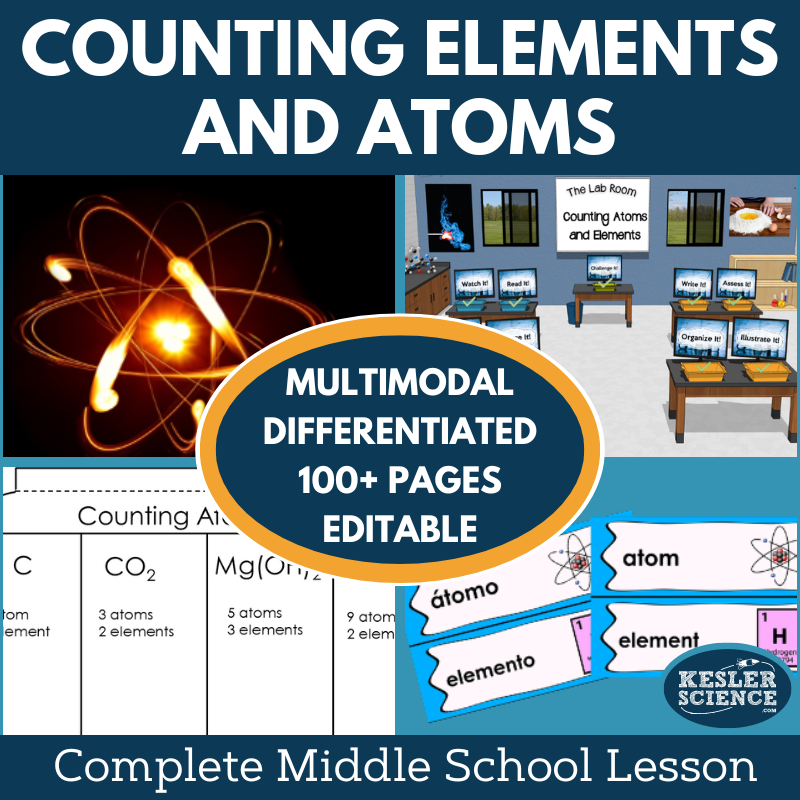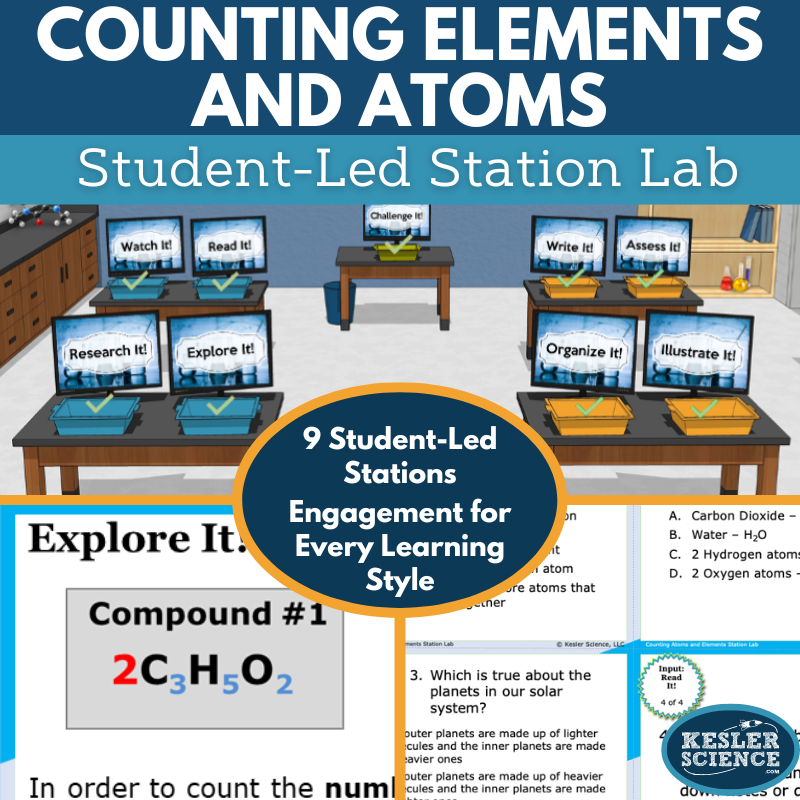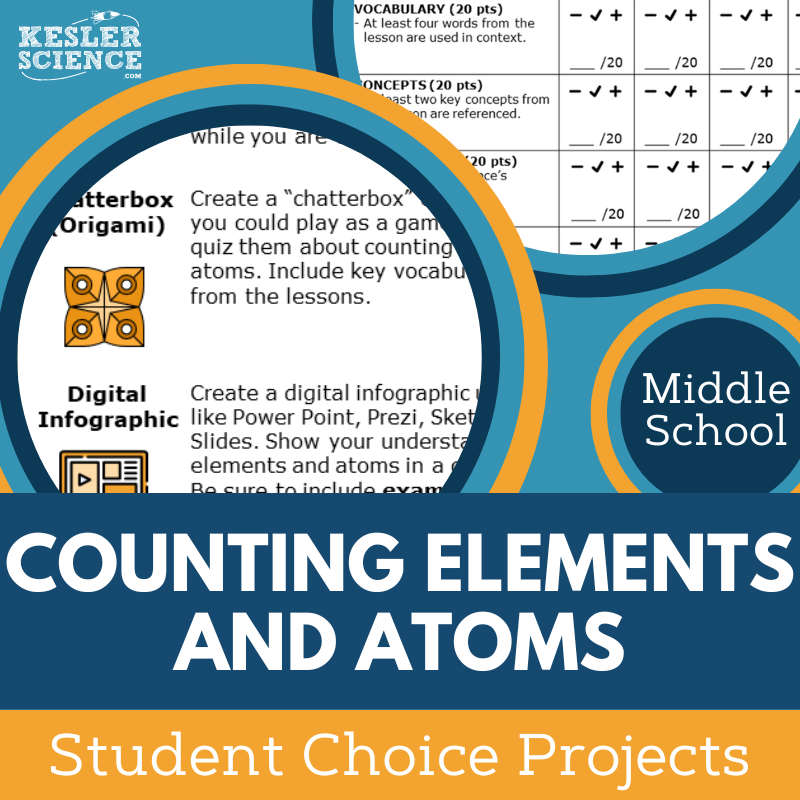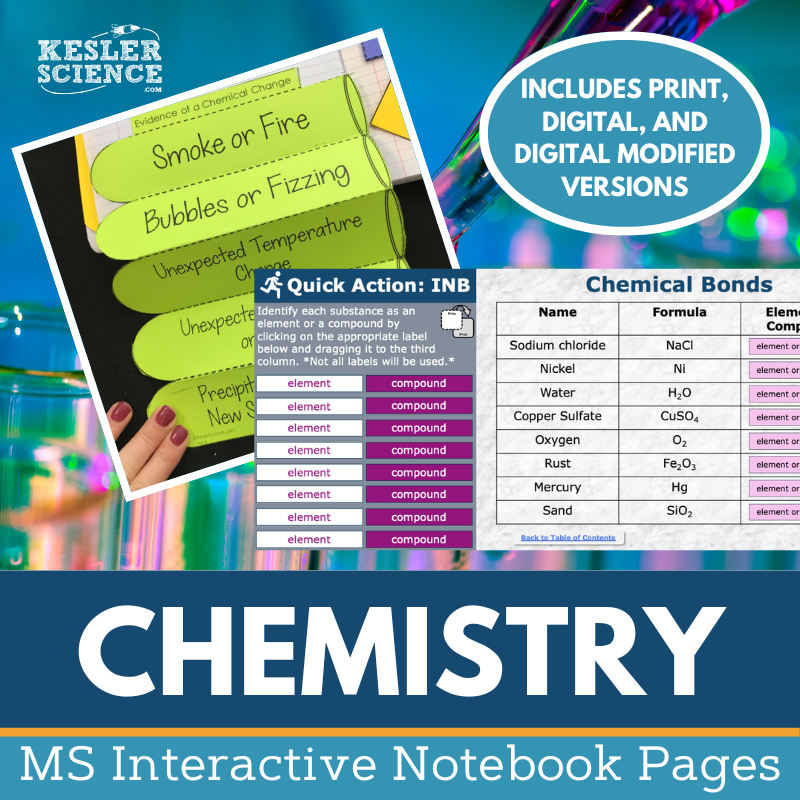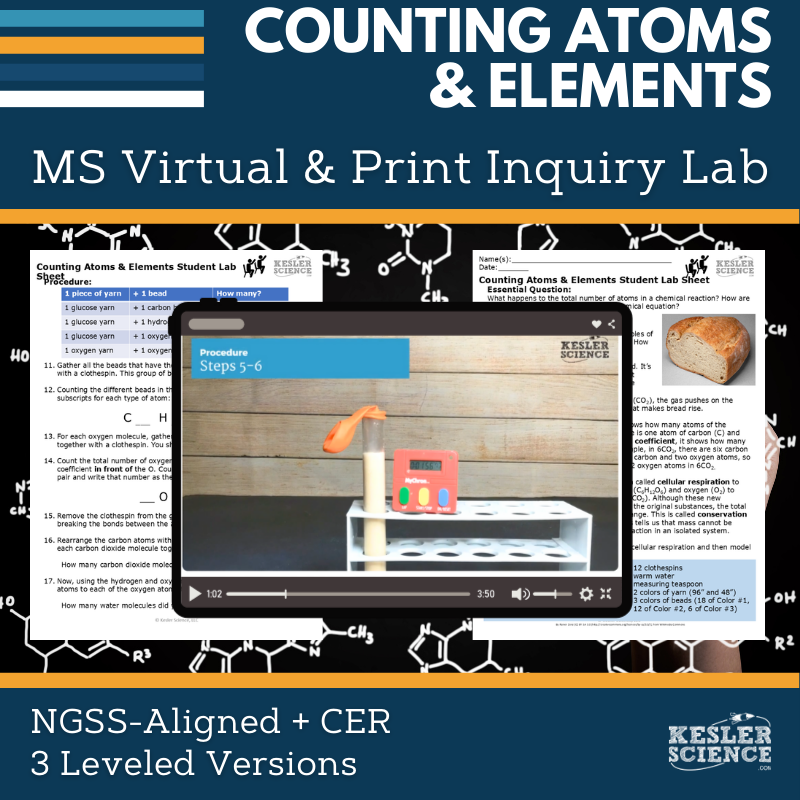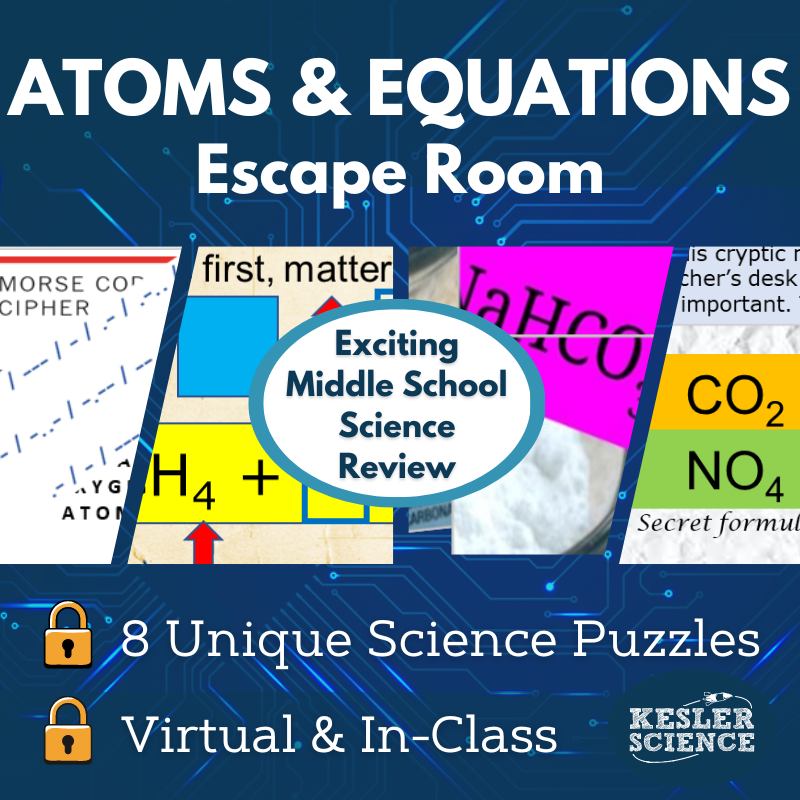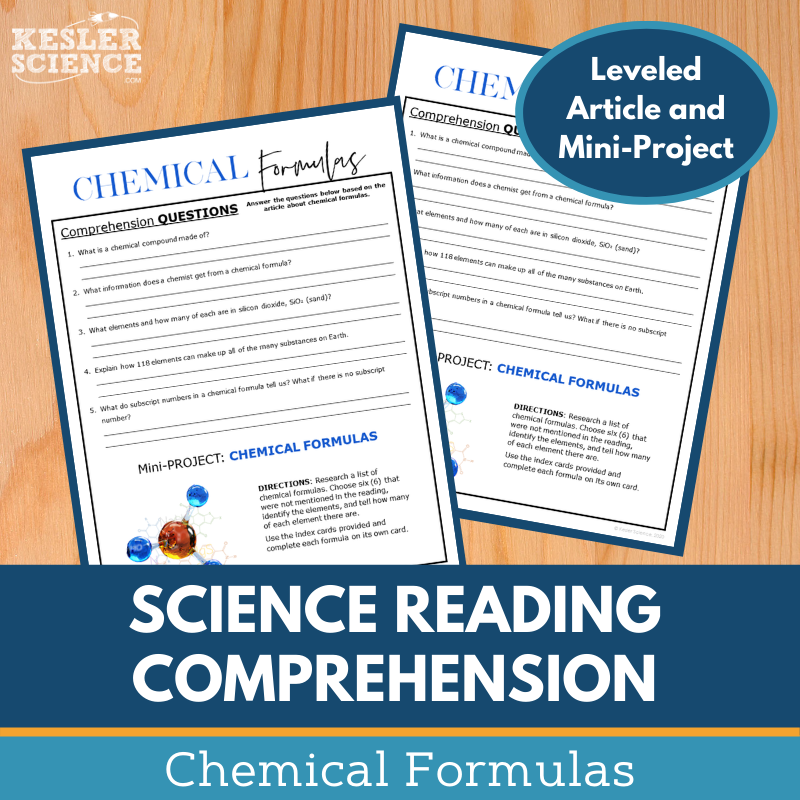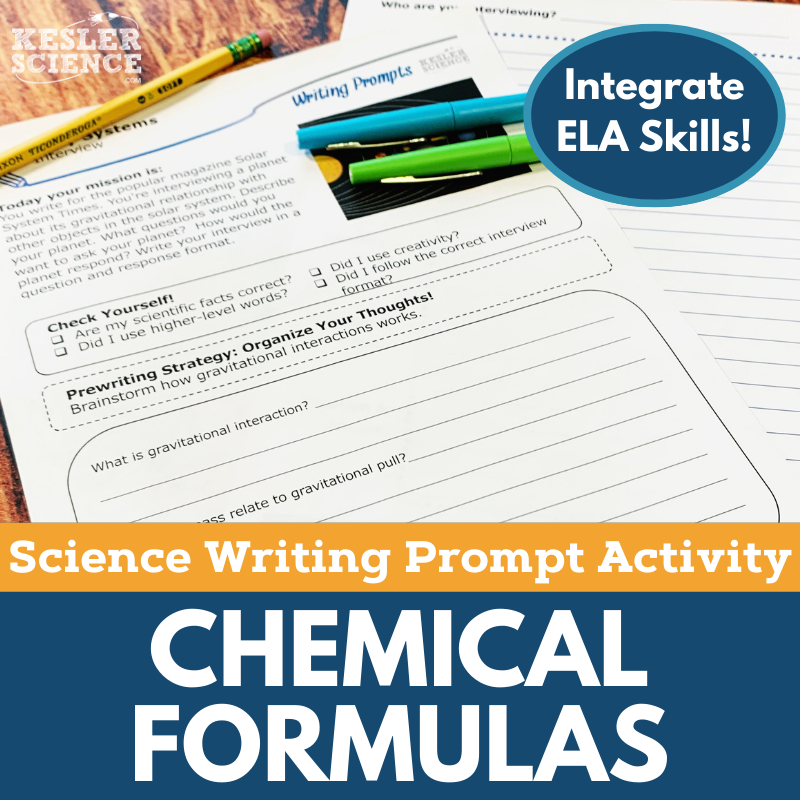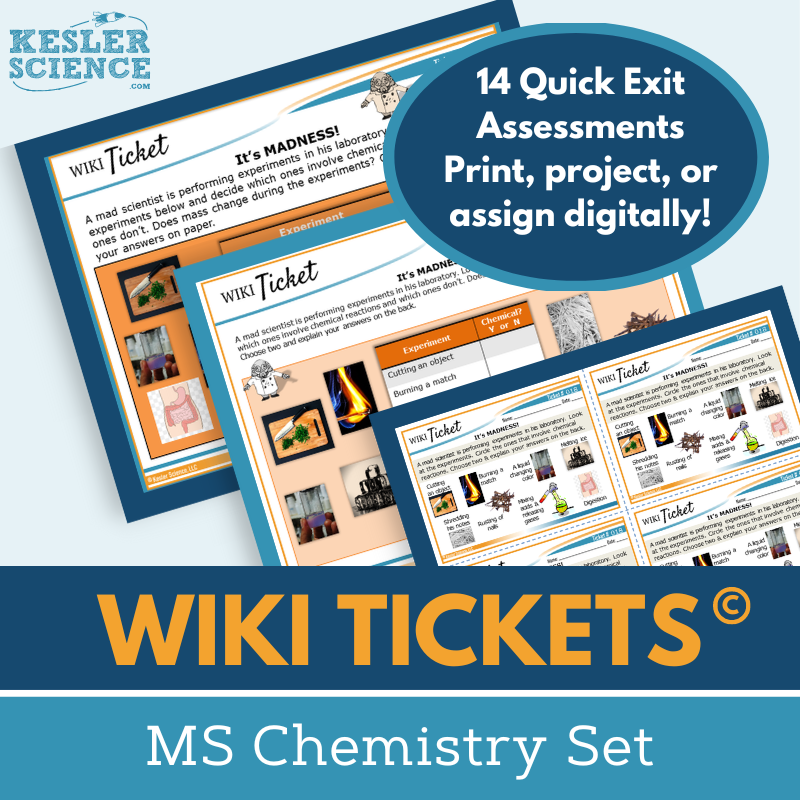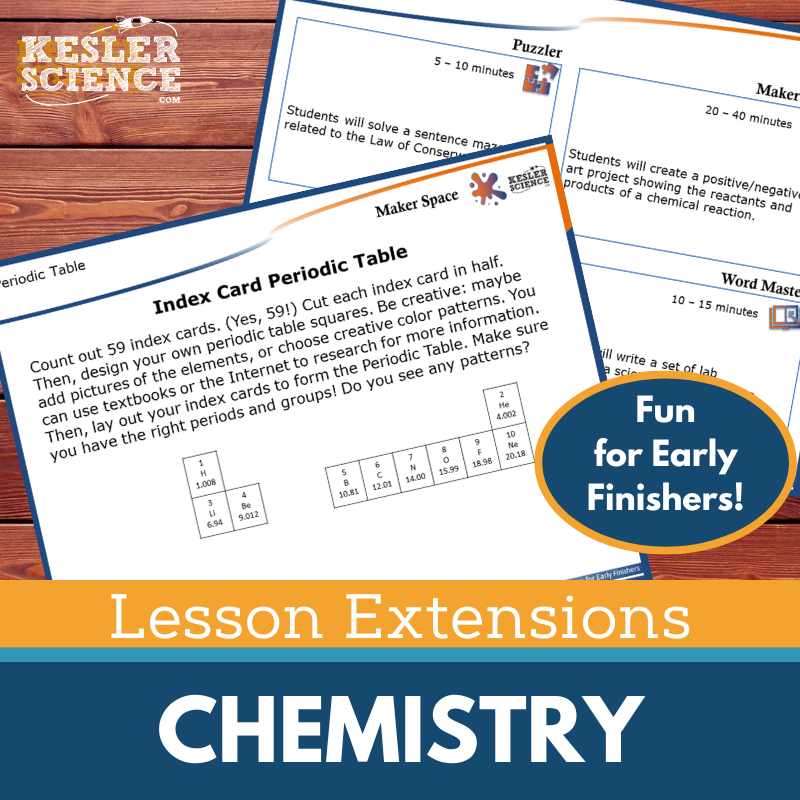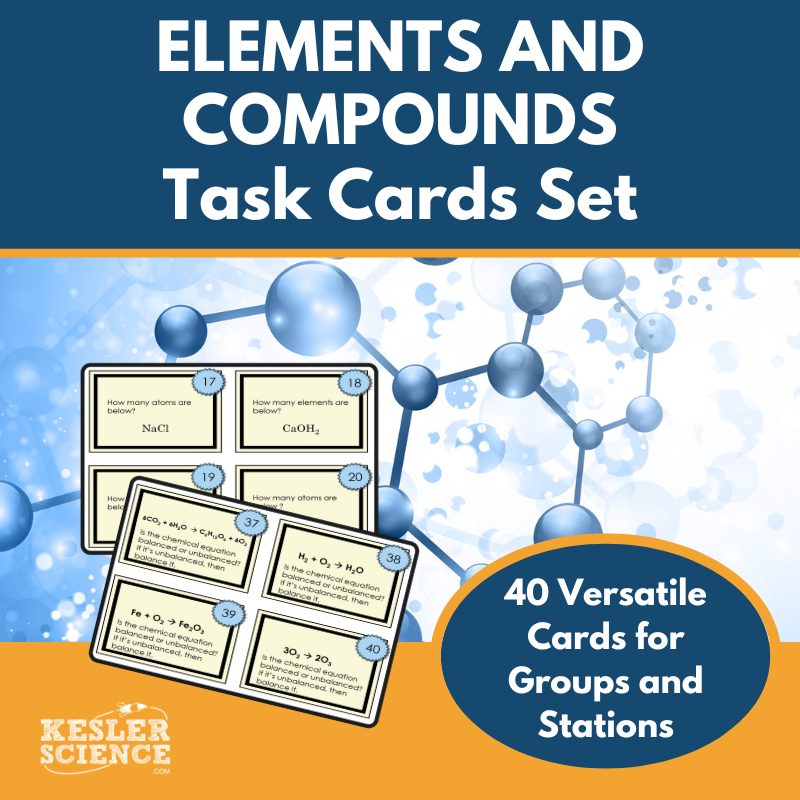Counting Elements and Atoms Activities for Middle School Science
The Kesler Science Counting Atoms and Elements resources offer a comprehensive, student-centered approach to teaching chemical formulas, subscripts, and coefficients. The resources below will give students a comprehensive understanding of counting elements and atoms. All of the following materials are also included in the Kesler Science Membership.
The Kesler Science Counting Elements and Atoms Complete 5E Lesson provides everything needed for an engaging middle school unit on chemical formulas, subscripts, and coefficients. This comprehensive resource includes editable presentations, worksheets, student-choice projects, and assessments, all designed for multiday, low-prep implementation. With differentiated, student-led activities, teachers can focus on student success while fostering independent learning.
Grounded in the 5E Model, the lesson begins with engagement tools like vocabulary cards, discussion prompts, and class activities in both English and Spanish. Students then explore concepts through a nine-station lab featuring hands-on experiments, research tasks, and video discussions, catering to diverse learning styles. Explanation materials include editable PowerPoints, interactive notebook templates, and guided note-taking, helping students solidify their understanding. Elaboration opportunities allow students to extend their learning with creative, student-choice projects, while evaluation materials include flexible assessments and review questions to measure mastery.
This versatile lesson, designed for in-person or virtual learning environments, delivers accessible, multimodal instruction that keeps students engaged while ensuring they develop a deep understanding of counting atoms and elements.
The Kesler Science Counting Elements and Atoms Complete 5E Lesson provides everything needed for an engaging middle school unit on chemical formulas, subscripts, and coefficients. This comprehensive resource includes editable presentations, worksheets, student-choice projects, and assessments, all designed for multiday, low-prep implementation. With differentiated, student-led activities, teachers can focus on student success while fostering independent learning.
Grounded in the 5E Model, the lesson begins with engagement tools like vocabulary cards, discussion prompts, and class activities in both English and Spanish. Students then explore concepts through a nine-station lab featuring hands-on experiments, research tasks, and video discussions, catering to diverse learning styles. Explanation materials include editable PowerPoints, interactive notebook templates, and guided note-taking, helping students solidify their understanding. Elaboration opportunities allow students to extend their learning with creative, student-choice projects, while evaluation materials include flexible assessments and review questions to measure mastery.
This versatile lesson, designed for in-person or virtual learning environments, delivers accessible, multimodal instruction that keeps students engaged while ensuring they develop a deep understanding of counting atoms and elements.
Engage your middle school students with this student-led station lab designed to help them model and understand the atomic composition of simple molecules and extended structures. This modular, low-prep activity encourages students to take charge of their learning through nine differentiated, interactive stations that support both in-class and virtual environments. The lab is part of the full Counting Elements and Atoms 5E Lesson Plan, which includes presentations, interactive notebook activities, assessments, and more.
Each station offers a unique approach to learning. Input stations introduce content through readings, videos, research, and hands-on exploration, including differentiated reading passages in English and Spanish. Output stations let students demonstrate mastery through written responses, illustrations, graphic organizers, and model construction. A bonus Challenge It! station offers extension activities for early finishers, promoting deeper exploration through games and mini-projects.
All necessary materials—signage, task cards, and student response sheets—are included and ready to use with PowerPoint or Google Slides. This differentiated, student-centered experience is ideal for promoting engagement, critical thinking, and conceptual understanding of counting atoms and elements in a flexible format.
Engage your middle school students with this student-led station lab designed to help them model and understand the atomic composition of simple molecules and extended structures. This modular, low-prep activity encourages students to take charge of their learning through nine differentiated, interactive stations that support both in-class and virtual environments. The lab is part of the full Counting Elements and Atoms 5E Lesson Plan, which includes presentations, interactive notebook activities, assessments, and more.
Each station offers a unique approach to learning. Input stations introduce content through readings, videos, research, and hands-on exploration, including differentiated reading passages in English and Spanish. Output stations let students demonstrate mastery through written responses, illustrations, graphic organizers, and model construction. A bonus Challenge It! station offers extension activities for early finishers, promoting deeper exploration through games and mini-projects.
All necessary materials—signage, task cards, and student response sheets—are included and ready to use with PowerPoint or Google Slides. This differentiated, student-centered experience is ideal for promoting engagement, critical thinking, and conceptual understanding of counting atoms and elements in a flexible format.
The Kesler Science Counting Elements and Atoms Student Choice Projects provide middle school students with engaging, creative ways to demonstrate their understanding of elements and atoms. With six student-led project options, plus a “design your own” choice, students can personalize their learning experience. An editable grading rubric supports assessments by teachers, peers, or students themselves.
This resource includes differentiated project pages to accommodate various needs, with modified options for remediation and advanced challenges for high achievers. Projects utilize common classroom supplies like paper, markers, and scissors, with digital and hands-on crafting options available.
Perfect for flexible use, these multimodal projects promote creativity and personalized learning while supporting teacher customization. Note: This product is also part of the Chemistry Complete Lesson Bundle.
The Kesler Science Counting Elements and Atoms Student Choice Projects provide middle school students with engaging, creative ways to demonstrate their understanding of elements and atoms. With six student-led project options, plus a “design your own” choice, students can personalize their learning experience. An editable grading rubric supports assessments by teachers, peers, or students themselves.
This resource includes differentiated project pages to accommodate various needs, with modified options for remediation and advanced challenges for high achievers. Projects utilize common classroom supplies like paper, markers, and scissors, with digital and hands-on crafting options available.
Perfect for flexible use, these multimodal projects promote creativity and personalized learning while supporting teacher customization. Note: This product is also part of the Chemistry Complete Lesson Bundle.
The Kesler Science Chemistry Interactive Notebook Bundle provides an engaging way for students to explore chemistry concepts through interactive activities. Designed for both traditional classrooms and digital learning environments, this bundle includes print and digital versions, making it versatile for in-person, 1:1, or distance learning settings.
Topics covered include acids and bases, atoms, balancing chemical equations, chemical bonds, physical and chemical changes, the periodic table, properties of water, and more. The digital version features a unique PowerPoint interactive notebook that can be uploaded to platforms like Google Slides, MS Teams, or Schoology. It includes reflection pages, note-taking space, a teacher answer key, and a modified version for students needing accommodations.
The paper version offers blank templates for student interaction, pre-filled options for modified learners or absentees, and visual examples for guidance. This resource is ideal for fostering hands-on and digital engagement in middle school chemistry.
The Kesler Science Chemistry Interactive Notebook Bundle provides an engaging way for students to explore chemistry concepts through interactive activities. Designed for both traditional classrooms and digital learning environments, this bundle includes print and digital versions, making it versatile for in-person, 1:1, or distance learning settings.
Topics covered include acids and bases, atoms, balancing chemical equations, chemical bonds, physical and chemical changes, the periodic table, properties of water, and more. The digital version features a unique PowerPoint interactive notebook that can be uploaded to platforms like Google Slides, MS Teams, or Schoology. It includes reflection pages, note-taking space, a teacher answer key, and a modified version for students needing accommodations.
The paper version offers blank templates for student interaction, pre-filled options for modified learners or absentees, and visual examples for guidance. This resource is ideal for fostering hands-on and digital engagement in middle school chemistry.
The Counting Atoms and Elements Inquiry Lab guides students in modeling the conservation of mass during a chemical reaction. Students observe the chemical changes in cellular respiration and then build a model to demonstrate how atoms are conserved. Both print and digital versions include comprehension questions, C.E.R. writing prompts, and a reflection section to deepen understanding.
The lab is available in three differentiated formats—dependent, modified, and independent—to support a range of learners. The print version involves a hands-on activity with materials such as yeast, sugar, balloons, and beads to visualize cellular respiration. The digital version includes a complete lab video demonstration and interactive slides, allowing students to follow along virtually, even without physical materials.
Editable files are included for maximum flexibility, with versions compatible with Google Slides and PowerPoint. Teacher support materials, such as answer keys and setup instructions, make planning and grading easier. Whether used in-person or remotely, this lab provides an engaging, multimodal experience to explore chemical reactions and the conservation of mass.
The Counting Atoms and Elements Inquiry Lab guides students in modeling the conservation of mass during a chemical reaction. Students observe the chemical changes in cellular respiration and then build a model to demonstrate how atoms are conserved. Both print and digital versions include comprehension questions, C.E.R. writing prompts, and a reflection section to deepen understanding.
The lab is available in three differentiated formats—dependent, modified, and independent—to support a range of learners. The print version involves a hands-on activity with materials such as yeast, sugar, balloons, and beads to visualize cellular respiration. The digital version includes a complete lab video demonstration and interactive slides, allowing students to follow along virtually, even without physical materials.
Editable files are included for maximum flexibility, with versions compatible with Google Slides and PowerPoint. Teacher support materials, such as answer keys and setup instructions, make planning and grading easier. Whether used in-person or remotely, this lab provides an engaging, multimodal experience to explore chemical reactions and the conservation of mass.
The Kesler Science Atoms and Equations Escape Room is an engaging, student-centered activity that challenges middle school learners to apply their knowledge of counting atoms and evaluating balanced equations. Teachers can select from eight independent puzzles, allowing flexibility for varying class lengths and learning objectives. The escape room can be set up using simple materials like manila envelopes or enhanced with authentic props for a more immersive experience.
For digital learning, the activity includes a Single Student Digital Version compatible with Google Slides and a printable PDF option for at-home use. These formats ensure accessibility while maintaining copyright compliance. Comprehensive teacher directions, an editable PPT, and a detailed answer key make preparation seamless.
Students will enjoy solving unique puzzles, exploring clues, and completing the activity while developing critical thinking skills. With extras like a video challenge, prize ideas, and editable reward templates, this escape room guarantees a memorable learning experience.
The Kesler Science Atoms and Equations Escape Room is an engaging, student-centered activity that challenges middle school learners to apply their knowledge of counting atoms and evaluating balanced equations. Teachers can select from eight independent puzzles, allowing flexibility for varying class lengths and learning objectives. The escape room can be set up using simple materials like manila envelopes or enhanced with authentic props for a more immersive experience.
For digital learning, the activity includes a Single Student Digital Version compatible with Google Slides and a printable PDF option for at-home use. These formats ensure accessibility while maintaining copyright compliance. Comprehensive teacher directions, an editable PPT, and a detailed answer key make preparation seamless.
Students will enjoy solving unique puzzles, exploring clues, and completing the activity while developing critical thinking skills. With extras like a video challenge, prize ideas, and editable reward templates, this escape room guarantees a memorable learning experience.
In the Kesler Science Chemical Formulas Reading Comprehension activity, students explore how chemical formulas are used to identify substances and determine the number of atoms in compounds with subscripts. After reading a nonfiction article on chemical formulas, they complete comprehension questions and identify elements and atom quantities in various compounds. The lesson includes a mini-project that reinforces understanding through hands-on activities.
The reading comprehension activities, appropriate for middle school grades 6-8, feature leveled passages (Lexile 1100-1300) designed to enhance reading and science literacy. The mini-project is interactive, and students can use Cornell notes to support their learning. The lesson also includes colorful graphics, which are easily printable in grayscale, and is designed for both in-class and virtual learning environments.
This resource is perfect for distance learning, with files compatible with platforms like Google Classroom, MS Teams, and Canvas. It offers flexibility, making it ideal for absent students, extra credit, sub plans, or whole-class instruction. The article provides a foundation for excellent classroom discussions while building students' textual analysis and reading comprehension skills.
In the Kesler Science Chemical Formulas Reading Comprehension activity, students explore how chemical formulas are used to identify substances and determine the number of atoms in compounds with subscripts. After reading a nonfiction article on chemical formulas, they complete comprehension questions and identify elements and atom quantities in various compounds. The lesson includes a mini-project that reinforces understanding through hands-on activities.
The reading comprehension activities, appropriate for middle school grades 6-8, feature leveled passages (Lexile 1100-1300) designed to enhance reading and science literacy. The mini-project is interactive, and students can use Cornell notes to support their learning. The lesson also includes colorful graphics, which are easily printable in grayscale, and is designed for both in-class and virtual learning environments.
This resource is perfect for distance learning, with files compatible with platforms like Google Classroom, MS Teams, and Canvas. It offers flexibility, making it ideal for absent students, extra credit, sub plans, or whole-class instruction. The article provides a foundation for excellent classroom discussions while building students' textual analysis and reading comprehension skills.
The Chemical Formulas Writing Prompt Activity engages middle school students in a creative letter-writing task that reinforces their understanding of physical science concepts. Aligned with NGSS and TEKS standards, this print-or-digital activity allows students to demonstrate their knowledge of chemical formulas while extending their science reasoning and writing skills. Designed to support both in-person and virtual learning, the activity keeps students involved in science exploration inside or outside the classroom.
This resource includes teacher directions, answer keys, rubrics, and both full-sized and half-sheet handouts. A digital PowerPoint version is also included for use in Google Slides, making it easy to assign and complete virtually. Students complete a self-check, use pre-writing strategies, and write their final draft using a structured layout that can be displayed or collected in individual anthologies.
Ideal for use as a cross-curricular assignment, pre-test assessment, student choice project, or enrichment activity, this prompt is a flexible addition to any classroom. It works well for early finishers, extra credit, make-up work, or TELPAS samples and allows for easy differentiation. Prior knowledge of chemical formulas is assumed, as students are encouraged to apply what they’ve learned or research as needed.
The Chemical Formulas Writing Prompt Activity engages middle school students in a creative letter-writing task that reinforces their understanding of physical science concepts. Aligned with NGSS and TEKS standards, this print-or-digital activity allows students to demonstrate their knowledge of chemical formulas while extending their science reasoning and writing skills. Designed to support both in-person and virtual learning, the activity keeps students involved in science exploration inside or outside the classroom.
This resource includes teacher directions, answer keys, rubrics, and both full-sized and half-sheet handouts. A digital PowerPoint version is also included for use in Google Slides, making it easy to assign and complete virtually. Students complete a self-check, use pre-writing strategies, and write their final draft using a structured layout that can be displayed or collected in individual anthologies.
Ideal for use as a cross-curricular assignment, pre-test assessment, student choice project, or enrichment activity, this prompt is a flexible addition to any classroom. It works well for early finishers, extra credit, make-up work, or TELPAS samples and allows for easy differentiation. Prior knowledge of chemical formulas is assumed, as students are encouraged to apply what they’ve learned or research as needed.
The Kesler Science Chemistry WIKI Tickets provide a flexible and engaging way to assess 6th-8th grade students’ understanding of key science topics. Aligned with NGSS and TEKS standards, these formative assessments are designed for both in-person and virtual learning environments. Each of the 14 topics includes multiple formats: a display version for projection, three printable handout sizes, and interactive digital files available as editable PowerPoint or Google Slides. A bonus table of contents ensures clear alignment with standards, and all topics include at least one ticket, with some offering more.
WIKI Tickets, standing for "What I Know Is," can serve as exit tickets, bellringers, or quick checks for understanding. Students can respond digitally or on paper, depending on the setting. Topics such as atomic structure, density, chemical reactions, and periodic table arrangement are covered, offering a comprehensive approach to middle school chemistry.
The Kesler Science WIKI Tickets are colorful, versatile, and designed to meet the demands of any learning scenario. Whether in a classroom or remote setting, these assessments provide a fun and meaningful way to gauge student progress while keeping them engaged.
The Kesler Science Chemistry WIKI Tickets provide a flexible and engaging way to assess 6th-8th grade students’ understanding of key science topics. Aligned with NGSS and TEKS standards, these formative assessments are designed for both in-person and virtual learning environments. Each of the 14 topics includes multiple formats: a display version for projection, three printable handout sizes, and interactive digital files available as editable PowerPoint or Google Slides. A bonus table of contents ensures clear alignment with standards, and all topics include at least one ticket, with some offering more.
WIKI Tickets, standing for "What I Know Is," can serve as exit tickets, bellringers, or quick checks for understanding. Students can respond digitally or on paper, depending on the setting. Topics such as atomic structure, density, chemical reactions, and periodic table arrangement are covered, offering a comprehensive approach to middle school chemistry.
The Kesler Science WIKI Tickets are colorful, versatile, and designed to meet the demands of any learning scenario. Whether in a classroom or remote setting, these assessments provide a fun and meaningful way to gauge student progress while keeping them engaged.
The Kesler Science Chemistry Lesson Extensions offer an engaging solution for keeping fast finishers motivated and learning. By incorporating activities that challenge critical thinking and creativity, these extensions are ideal for filling downtime during testing, curbing distractions, and wrapping up lessons. They provide rigorous yet enjoyable opportunities for students ready to delve deeper into NGSS and TEKS chemistry standards.
Each Lesson Extension includes four creative activities designed to enrich the learning experience. The Puzzler improves problem-solving skills through relevant puzzles, while the Maker Space integrates STEAM connections with hands-on projects. The Tech Connection allows students to demonstrate their learning through digital media, and the Word Master brings creative writing into the science classroom. Teachers are supported with clear directions, answer keys, and resources available in both projection and print-friendly formats.
This bundle covers essential topics such as the periodic table, chemical reactions, synthetic materials, and atomic structures. These versatile tools provide high-level supplementary materials to challenge independent learners and offer a meaningful way to conclude chemistry lessons with engagement and purpose.
The Kesler Science Chemistry Lesson Extensions offer an engaging solution for keeping fast finishers motivated and learning. By incorporating activities that challenge critical thinking and creativity, these extensions are ideal for filling downtime during testing, curbing distractions, and wrapping up lessons. They provide rigorous yet enjoyable opportunities for students ready to delve deeper into NGSS and TEKS chemistry standards.
Each Lesson Extension includes four creative activities designed to enrich the learning experience. The Puzzler improves problem-solving skills through relevant puzzles, while the Maker Space integrates STEAM connections with hands-on projects. The Tech Connection allows students to demonstrate their learning through digital media, and the Word Master brings creative writing into the science classroom. Teachers are supported with clear directions, answer keys, and resources available in both projection and print-friendly formats.
This bundle covers essential topics such as the periodic table, chemical reactions, synthetic materials, and atomic structures. These versatile tools provide high-level supplementary materials to challenge independent learners and offer a meaningful way to conclude chemistry lessons with engagement and purpose.
These chemistry task cards provide engaging practice for middle school students on essential topics such as elements and compounds, counting atoms, identifying physical and chemical changes, and interpreting chemical equations. Students will work through scenarios that help them distinguish between compounds and elements, recognize signs of chemical changes, and determine whether chemical equations are balanced or unbalanced.
The 40 task cards can be used flexibly in a variety of classroom settings, including station labs, small group work, or whole-class reviews. Each set includes a student data sheet and a teacher answer key. This resource aligns with TEKS standards 8.5D, 8.5E, 8.5F, 7.6B, and 6.5C.
These chemistry task cards provide engaging practice for middle school students on essential topics such as elements and compounds, counting atoms, identifying physical and chemical changes, and interpreting chemical equations. Students will work through scenarios that help them distinguish between compounds and elements, recognize signs of chemical changes, and determine whether chemical equations are balanced or unbalanced.
The 40 task cards can be used flexibly in a variety of classroom settings, including station labs, small group work, or whole-class reviews. Each set includes a student data sheet and a teacher answer key. This resource aligns with TEKS standards 8.5D, 8.5E, 8.5F, 7.6B, and 6.5C.
This Amazing Anchors Phenomenon Lesson introduces and reinforces the concept of chemical formulas through a real-world mystery liquids scenario. The lesson begins with an engaging introductory reading accompanied by comprehension and extension questions to spark curiosity and prepare students for deeper learning. It concludes with an explanatory reading that breaks down the science of chemical formulas in a clear and accessible way, with follow-up questions to reinforce understanding.
Designed to bookend a main lesson, this TEKS-aligned resource fits seamlessly into the Engagement and Elaborate phases of a 5E instructional model. It includes teacher directions with answer keys, full-page projection slides, and editable materials in both print and digital formats. Students can interact with the content using either full- or half-sheet handouts, making it easy to incorporate into any classroom setup.
Differentiation is built in with a modified version that supports struggling learners using simpler language and sentence starters. Whether used in person or virtually, this no-prep activity helps students connect abstract concepts in chemistry to real-life applications.
This Amazing Anchors Phenomenon Lesson introduces and reinforces the concept of chemical formulas through a real-world mystery liquids scenario. The lesson begins with an engaging introductory reading accompanied by comprehension and extension questions to spark curiosity and prepare students for deeper learning. It concludes with an explanatory reading that breaks down the science of chemical formulas in a clear and accessible way, with follow-up questions to reinforce understanding.
Designed to bookend a main lesson, this TEKS-aligned resource fits seamlessly into the Engagement and Elaborate phases of a 5E instructional model. It includes teacher directions with answer keys, full-page projection slides, and editable materials in both print and digital formats. Students can interact with the content using either full- or half-sheet handouts, making it easy to incorporate into any classroom setup.
Differentiation is built in with a modified version that supports struggling learners using simpler language and sentence starters. Whether used in person or virtually, this no-prep activity helps students connect abstract concepts in chemistry to real-life applications.
Year-Round Resources
These year-round activities will increase your students' understanding of many middle school science topics. All of these activities are also included in the Kesler Science Membership.
Visual Data & Graphing
You're not alone if your students struggle with understanding graphs, charts, and tables. It's a skill that takes an enormous amount of practice. This resource will help students build a strong foundation in analyzing data and creating their own data visualizations.
Bell Ringers and Warm-Ups
These middle school science bell ringers are an excellent way to engage your students as soon as they walk into your classroom. This comprehensive FULL YEAR resource includes everything you need to start off each science class with an interesting warm-up activity.
Review Board Games
Each game board has been carefully designed to keep students engaged. There are 10 different action spaces on each board and dozens of question cards. All of the actions are related to science concepts and keep the students motivated throughout the game.
Each game is ready to play. Simply print out the board and the cards and let the students enjoy reviewing nine different units.
Essential Questions
Below are the essential questions associated with the lessons and activities included in this unit. This topic is only one of more than 100 middle school science topics included in the Kesler Science Membership.
-
How are chemical formulas used to identify substances?
-
How do chemical formulas determine the number of atoms of each element using subscripts, coefficients, and parenthesis?
Kesler Science Membership
Imagine never having to search for another middle school science lesson again. The membership gives you access to ALL of the Kesler Science products in one place (Yes, including everything above).
Say goodbye to long hours of lesson prep.

